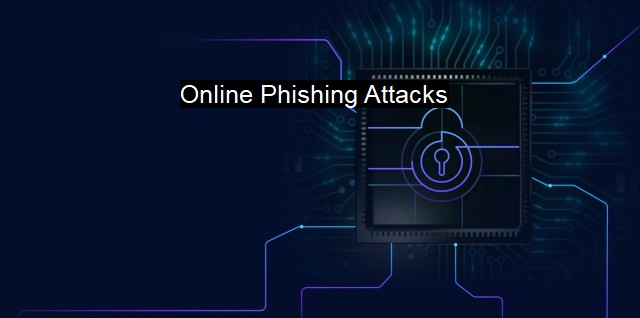What are Online Phishing Attacks?
Phishing Attacks: Understanding the Threats, Impacts and Safeguards for Individuals and Organizations
Online Phishing Attacks are one of the most common methods hackers use to infiltrate a system or trick unsuspecting internet users into revealing their personal details like passwords, bank details, or credit card numbers. a form of cybercrime characterized as a blend of social engineering and cyber deception, phishing attacks pose one of the leading threats to cybersecurity.Phishing is an illicit practice that involves sending fraudulent emails purporting to be from reputable sources such as banks, internet service providers, or other familiar institutions. Cybercriminals typically cast out thousands of “phishing” emails, akin to a fisherman casting a wide net, hoping that even a small percentage of responses can result in significant informational gain. This type of cyberattack compels the target to undertake an action, usually to click on the malicious links included in the email or download an infected attachment.
The unsuspecting internet user perceives the source as a trusted entity since the email can mimic the authentic fonts, logos, and even email addresses closely. Once a user acts on the request mentioned in the email, the malicious software infects the user’s computer or the user gets redirected to a fake website where they're asked to provide personal data.
Several types of online phishing attacks exist. The most common type is deceptive phishing where the attacker impersonates a legitimate organization and tries to steal the user's login credentials or credit card information. Spear phishing targets certain individuals instead of a wide public swath, while pharming diverts users from legitimate sites to false ones. Other types are clone phishing, whaling, and snowshoeing, all having the same motive of data theft in one way or another.
The repercussions of falling victim to an online phishing attack can be severe. It can lead to unauthorized purchases, identity theft, or pirating of sensitive organizational information if it's a corporate scenario. Oftentimes, the victim will not realize they have been attacked until they check bank statements or receive notifications of irregular activity.
In today's hyper-connected era, these threats face not just individuals but also businesses and public organizations. It necessitates the prudent use of reliable antivirus and security systems, crucial in detecting and governing threats. Antivirus softwares employ various sophisticated technologies like signature-based detection, heuristic/behavioral analysis, sandboxing, and data mining to detect potentially harmful phishing emails and links.
Apart from antivirus solutions, organizations and individuals must take steps to preserve their cybersecurity. Securing strong, unique passwords, employing two-factor authentication, keeping softwares up-to-date, conducting frequent security awareness training, and avoiding click-based interactions in pop-up ads or unsolicited emails help significantly in acting against phishing.
a fine balance between human vigilance and automatic defense mechanisms is beneficial. Internet users must exercise extreme caution while interacting with emails, especially if they contain links or direct users to enter personal information. They must double-check email addresses, URLs, and hover over links to inspect their destination.
Indeed, in an age where cyber risk is evolving at an uncaught pace, understanding and striving to thwart online phishing attacks forms an essential schema of cybersecurity. Being vigilant and employing effective security measures, whether you're an individual or large corporation, has the potential to deflect the repercussions of catastrophic cyberattacks and secure the cyberspace dominion.

Online Phishing Attacks FAQs
What is an online phishing attack?
An online phishing attack is a type of cyber attack in which an attacker creates a fake website, email or message that appears to be from a legitimate source, but is actually designed to trick the victim into giving away their sensitive information such as login credentials, credit card details, or personal information.How can I protect myself from online phishing attacks?
To protect yourself from online phishing attacks, you should avoid clicking on suspicious links or downloading attachments from unknown sources. You should also keep your antivirus software and web browser up-to-date and be cautious when sharing personal information online. Additionally, using two-factor authentication and complex passwords can also help protect against online phishing attacks.What are some common signs of an online phishing attack?
Some common signs of an online phishing attack include suspicious links, poor grammar or spelling errors in emails or messages, requests for personal or sensitive information, and urgent or threatening language. It's important to be cautious and verify the legitimacy of any emails or messages before providing any personal information or clicking on any links.What should I do if I fall victim to an online phishing attack?
If you fall victim to an online phishing attack, you should immediately change your passwords for any accounts that may have been compromised, and contact your bank or financial institution to report any suspicious activity. You should also consider running a full system scan with your antivirus software to detect and remove any malicious software that may have been installed on your device. Lastly, you may want to consider enrolling in an identity theft protection service to monitor your personal information and help prevent further damage.| | A | | | B | | | C | | | D | | | E | | | F | | | G | | | H | | | I | | | J | | | K | | | L | | | M | |
| | N | | | O | | | P | | | Q | | | R | | | S | | | T | | | U | | | V | | | W | | | X | | | Y | | | Z | |
| | 1 | | | 2 | | | 3 | | | 4 | | | 7 | | | 8 | | |||||||